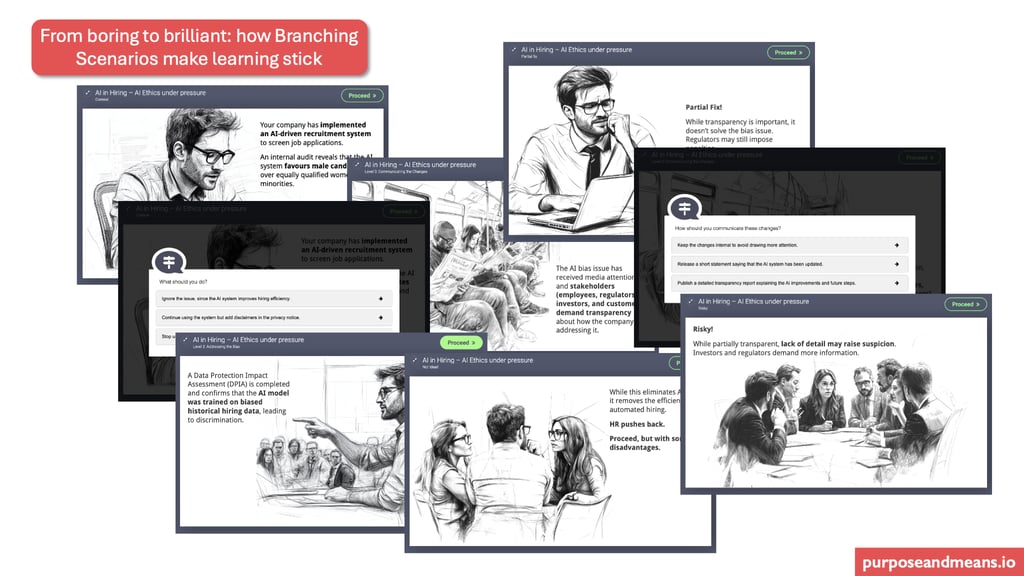Why Branching Scenarios are the ultimate tool for employee engagement
Branching scenarios transform employee education by creating interactive, real-world decision-making experiences that boost engagement, improve retention, and drive meaningful behavioural change.
EMPLOYEE AWARENESSEDUCATION AND TRAININGAI, DATA PROTECTION AND ESGVIRTUAL COMMS. SUPPORT
Tim Clements
2/7/20253 min read


Employee engagement isn’t just a buzzword, it’s a necessity for companies looking to boost performance, improve decision-making, and build a culture of continuous learning. Nowadays, traditional education and training methods often fall flat, failing to keep employees interested or drive real behavioural change.
Enter branching scenarios, a powerful, interactive education method that immerses employees in real-world challenges, requiring them to think critically, make decisions, and see the consequences of their actions. Whether you’re educating employees on ESG (Environmental, Social, and Governance) policies, data protection, leadership skills, or customer service, branching scenarios offer a high-impact, engaging learning experience.
So why are branching scenarios so effective and how they can transform employee education?
1. Realistic, decision-based learning
One of the key advantages of branching scenarios is their real-world application. Unlike passive learning methods (such as lectures or static elearning courses), branching scenarios place employees in dynamic, decision-making roles.
For example, imagine a Data Protection Officer (DPO) faced with an ESG-related data protection challenge. Instead of reading about best practices, they navigate a realistic simulation where each decision, whether to suggest the company conduct a Data Protection Impact Assessment (DPIA), advise on an AI bias issue, or keep compliance efforts minimal, it all affects the outcome.
By mimicking real-life complexities, employees engage deeply and retain more knowledge compared to traditional training.
2. Immediate feedback and consequence awareness
Many employees don’t just want to know the right answer, they want to understand why it’s the right answer. Branching scenarios give immediate feedback, showing employees how their decisions impact compliance, ethics, business outcomes, and stakeholder trust.
For example, in a scenario about Green IT and Data Storage, an employee might need to balance data minimisation, purpose limitation as well as considering environmental impacts. Instead of simply stating 'this is wrong,' the scenario demonstrates the consequences, increased carbon footprint, GDPR non-compliance, and ESG reputational risks.
This type of cause-and-effect learning is far more effective than passive training because employees experience the results of their choices firsthand.
3. High engagement through interactivity
Employee engagement suffers when learning is passive and repetitive. PowerPoint slides, long policy documents, and traditional e-learning modules often result in low retention rates because they fail to hold employees' attention.
Branching scenarios, on the other hand, turn learning into an interactive experience, one that feels like a game rather than a lecture. Employees must:
Make decisions under realistic constraints
Explore multiple outcomes based on their choices
Problem-solve and strategise, rather than memorise facts
This keeps employees engaged and motivated, making learning more immersive and impactful.
4. Safe space for learning from mistakes
One of the biggest barriers to effective decision-making in the workplace is the fear of making mistakes. Employees often hesitate to take action because they worry about the consequences.
Branching scenarios provide a safe, simulated environment where employees can make mistakes, explore different approaches, and learn without real-world risks.
For example, in a scenario about AI bias in hiring, an HR manager may initially ignore an AI-driven discrimination issue. When the scenario reveals that this choice leads to GDPR fines and reputational damage, the employee experiences the mistake without real-world consequences.
This kind of fail-safe learning environment helps employees develop better critical thinking and decision-making skills over time.
5. Aligns with business goals & compliance needs
Branching scenarios don’t just enhance learning, they can be strategically designed to align with key business objectives.
For instance, companies focused on ESG compliance can use branching scenarios to:
Train employees on ethical AI practices
Teach sustainable data storage habits
Improve transparency in ESG reporting
By integrating compliance-driven learning into engaging, decision-based training, businesses can ensure that employees are both informed and motivated to act responsibly.
6. Customisation for different roles & departments
One-size-fits-all training rarely works, because different employees face different challenges in their roles.
Branching scenarios offer customised learning paths, allowing employees to experience role-specific situations that apply directly to their job functions.
For example:
A customer service agent may navigate a scenario on handling consumer data responsibly.
An IT administrator may explore a cybersecurity breach scenario and decide how to respond.
A sustainability officer may manage a scenario on balancing carbon footprint reduction with business needs.
By personalising training experiences, branching scenarios make learning relevant and valuable to each employee.
7. Supports data-driven learning & improvement
One of the biggest advantages of digital learning is the ability to track progress and measure effectiveness. Our solution can integrate seamlessly into your LMS via LTI, ensuring all learner data and performance metrics flow directly into your system.
Branching scenarios capture data on employee decision-making, allowing companies to:
Identify common knowledge gaps
Assess decision-making trends
Refine training programs based on real user data
For example, if most employees struggle with AI transparency requirements, the company can adjust future training to focus more on that topic.
This data-driven approach ensures that training is continuously improving and addressing the most critical knowledge gaps.
If your company wants to move beyond checkbox compliance and create a true culture of learning, it’s time to start using branching scenarios in your training programmes.
Interested and want to know more? Feel free to book a no-obligation call to discuss your requirements.
Purpose and Means
Purpose and Means believes the business world is better when companies establish trust through impeccable governance.
BaseD in Copenhagen, OPerating Globally
tc@purposeandmeans.io
+45 6113 6106
© 2025. All rights reserved.
